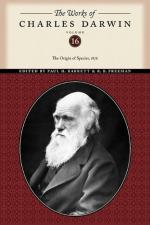It is worth while to reflect for a moment on the character of the new species F14, which is supposed not to have diverged much in character, but to have retained the form of (F), either unaltered or altered only in a slight degree. In this case, its affinities to the other fourteen new species will be of a curious and circuitous nature. Having descended from a form which stood between the two parent-species (A) and (I), now supposed to be extinct and unknown, it will be in some degree intermediate in character between the two groups descended from these species. But as these two groups have gone on diverging in character from the type of their parents, the new species (F14) will not be directly intermediate between them, but rather between types of the two groups; and every naturalist will be able to bring some such case before his mind.
In the diagram, each horizontal line has hitherto been supposed to represent a thousand generations, but each may represent a million or hundred million generations, and likewise a section of the successive strata of the earth’s crust including extinct remains. We shall, when we come to our chapter on Geology, have to refer again to this subject, and I think we shall then see that the diagram throws light on the affinities of extinct beings, which, though generally belonging to the same orders, or families, or genera, with those now living, yet are often, in some degree, intermediate in character between existing groups; and we can understand this fact, for the extinct species lived at very ancient epochs when the branching lines of descent had diverged less.
I see no reason to limit the process of modification, as now explained, to the formation of genera alone. If, in our diagram, we suppose the amount of change represented by each successive group of diverging dotted lines to be very great, the forms marked a14 to p14, those marked b14 and f14, and those marked o14 to m14, will form three very distinct genera. We shall also have two very distinct genera descended from (I) and as these latter two genera, both from continued divergence of character and from inheritance from a different parent, will differ widely from the three genera descended from (A), the two little groups of genera will form two distinct families, or even orders, according to the amount of divergent modification supposed to be represented in the diagram. And the two new families, or orders, will have descended from two species of the original genus; and these two species are supposed to have descended from one species of a still more ancient and unknown genus.




